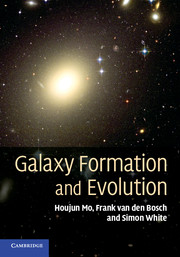Book contents
- Frontmatter
- Contents
- Preface
- 1 Introduction
- 2 Observational Facts
- 3 Cosmological Background
- 4 Cosmological Perturbations
- 5 Gravitational Collapse and Collisionless Dynamics
- 6 Probing the Cosmic Density Field
- 7 Formation and Structure of Dark Matter Halos
- 8 Formation and Evolution of Gaseous Halos
- 9 Star Formation in Galaxies
- 10 Stellar Populations and Chemical Evolution
- 11 Disk Galaxies
- 12 Galaxy Interactions and Transformations
- 13 Elliptical Galaxies
- 14 Active Galaxies
- 15 Statistical Properties of the Galaxy Population
- 16 The Intergalactic Medium
- A Basics of General Relativity
- B Gas and Radiative Processes
- C Numerical Simulations
- D Frequently Used Abbreviations
- E Useful Numbers
- References
- Index
12 - Galaxy Interactions and Transformations
Published online by Cambridge University Press: 05 June 2012
- Frontmatter
- Contents
- Preface
- 1 Introduction
- 2 Observational Facts
- 3 Cosmological Background
- 4 Cosmological Perturbations
- 5 Gravitational Collapse and Collisionless Dynamics
- 6 Probing the Cosmic Density Field
- 7 Formation and Structure of Dark Matter Halos
- 8 Formation and Evolution of Gaseous Halos
- 9 Star Formation in Galaxies
- 10 Stellar Populations and Chemical Evolution
- 11 Disk Galaxies
- 12 Galaxy Interactions and Transformations
- 13 Elliptical Galaxies
- 14 Active Galaxies
- 15 Statistical Properties of the Galaxy Population
- 16 The Intergalactic Medium
- A Basics of General Relativity
- B Gas and Radiative Processes
- C Numerical Simulations
- D Frequently Used Abbreviations
- E Useful Numbers
- References
- Index
Summary
So far we have treated galaxies as isolated, non-interacting systems. However, in the hierarchical scenario of structure formation, galaxies and their associated dark matter halos undergo frequent interactions with each other. As we have seen in §7.3.6, a large fraction of dark matter halos are expected to be dynamically young (i.e. to have experienced a merger event in their recent history). In fact, as shown by Li et al. (2007), each halo, independent of its mass, experiences about three major mergers (defined as mergers with a progenitor mass ratio larger than 1/3) after its main progenitor has acquired 1% of its present-day mass. Hence, galaxies and their associated dark matter halos cannot be considered isolated ‘island universes', but are constantly influenced by gravitational interactions with other systems. These interactions may have dramatic impact on the morphologies and star-formation histories of galaxies, making the study of their nature and frequency an important part of galaxy formation and evolution.
Consider a body S which has an encounter with a perturber P with impact parameter b and initial velocity v∞ (in the limit of infinite, initial separation between S and P). Let q be a particle (e.g. a star) in S, at a distance r(t) from the center of S, and let R(t) be the position vector of P from S (see Fig. 12.1 for an illustration).
- Type
- Chapter
- Information
- Galaxy Formation and Evolution , pp. 544 - 573Publisher: Cambridge University PressPrint publication year: 2010

